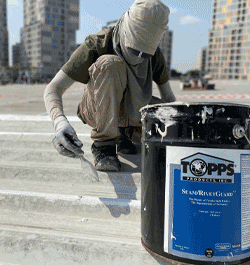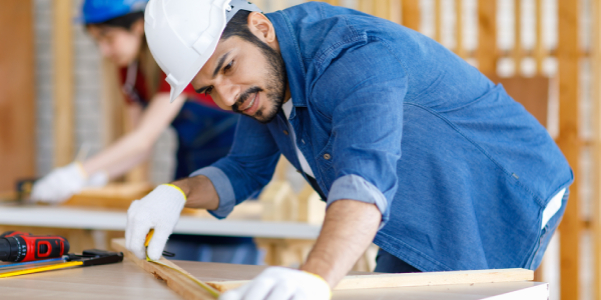UP TO THE MINUTE
Everything you need to know to navigate below-grade waterproofing

By Polyglass U.S.A., Inc.
Dive into critical considerations from interpreting geotechnical reports to selecting the right materials for your perfect waterproofing solution.
Planning an effective below-grade waterproofing system begins with a thorough analysis of site conditions and understanding the depth of the water table. Construction professionals can benefit from insights into factors such as hydrostatic pressure resistance, substrate types and installation conditions to ensure the longevity and reliability of their waterproofing systems.
Evaluating site conditions and water table depth
The first and critical step in planning a below-grade waterproofing system is analyzing site conditions and ascertaining the depth of the water table. The water table, which denotes the underground level saturated with water, is a pivotal factor in selecting the right waterproofing solution and insulation.
The depth of the water table varies across locations, ranging from shallow to considerable depths. The lower a structure sits beneath the water table, the more robust and specialized the waterproofing system required. Structures closer to the water table face a higher risk of hydrostatic pressure, the force exerted by water against foundation walls. To effectively counteract this pressure, choosing a waterproofing product capable of withstanding hydrostatic forces is crucial.
Unpacking geotechnical reports
Geotechnical reports are invaluable resources providing insights into site conditions, water table depth, soil contaminants and more. These reports offer crucial data to guide the selection of the appropriate below-grade waterproofing solution. Contaminants in the soil, such as chemicals and gases, can influence the choice of waterproofing materials to ensure their effectiveness and long-term durability.
Building types and special considerations
The nature of the building under construction can significantly influence the choice of a below-grade waterproofing system, particularly in densely developed urban areas with limited space. For example, “0 lot line” conditions, often encountered in cities like New York, call for blind-sided applications. In such scenarios, where space is constrained, and access is restricted, waterproofing applications must be carefully chosen to ensure effective coverage.
Pre-applied waterproofing products
Pre-applied waterproofing involves the application of waterproofing materials before pouring concrete. This approach averts water infiltration and establishes a watertight barrier from the outset. An example of a pre-applied waterproofing solution is Mapeproof™ AL Pro, renowned for its capacity to withstand hydrostatic head pressure. It securely bonds with the concrete, preventing lateral water migration and enhancing its effectiveness in safeguarding the structure.
Features of Mapeproof™ AL Pro
- Engineered for swift installation and decreased labor expenses as a kick-out roll
- Simple formation of self-adhered side laps, ensuring ease of use
- Concrete adhesive bonding capability inhibits lateral water movement
- Offers exceptional resistance to high hydrostatic pressure
- Unperturbed by ground settling, ensuring long-term stability
- Robust and self-protective, allowing immediate foot traffic for subsequent trade activities post-installation
- Remains unaffected by alternating wet/dry cycles or pooling water
- Provides excellent defense against chemicals and shields from potential gas vapor intrusion
- Completely free of red list materials, ensuring an eco-friendly and sustainable choice
Bentonite technology and mechanically bonded systems
Bentonite-based waterproofing products, whether applied before or after concrete, rely on clay’s expansion upon contact with water. However, their effectiveness necessitates continuous confinement. While Bentonite suits certain conditions, it might not endure severe hydrostatic conditions. In contrast, mechanically bonded systems create pathways for water to traverse concrete surfaces but may lack the adhesion and efficacy of adhesively bonded systems like Mapeproof AL Pro.
Adhesively bonded systems: Advantages
Adhesively bonded systems deliver superior waterproofing performance, particularly in the presence of hydrostatic conditions. Fully bonded HDPE waterproofing membranes such as Mapeproof AL Pro ensure that water cannot pass through voids, even in the event of a breach. This is critical in preventing lateral water migration, guaranteeing the accuracy of leak detection, and reducing the cost of repairs.
Post-applied waterproofing products
Post-applied waterproofing entails installing a waterproofing membrane after pouring the concrete wall. Products like Mapethene™ HT60 or LT60 offer dependable protection against water infiltration, especially when the membrane is adequately safeguarded from potential punctures during backfilling.
Features of Mapethene™HT60 and LT60
- Application without the need for open flames; cold applied for safety
- Precisely controlled thickness maintained in the factory
- Exceptional flexibility, allowing for a straightforward and rapid application process
- Self-adhesive overlapping capability and outstanding adhesion to a variety of surfaces
- Elastomeric nature accommodates concrete shrinkage effectively
- Impressive chemical resistance and safeguards against the intrusion of gas vapor
Considerations for fluid applied products
Fluid-applied waterproofing products are gaining popularity due to their adaptability and effectiveness in sealing structures against water intrusion. These products offer a dynamic approach to waterproofing, creating a continuous, impermeable barrier over various surfaces. Let’s delve deeper into some of the key considerations when choosing fluid-applied solutions:
- Versatility and seamless application: Fluid-applied waterproofing products are incredibly versatile. They can be applied to a wide range of surfaces, including concrete, metal, wood, and more. The liquid nature of these products allows for a seamless application process, ensuring there are no gaps or seams where water could potentially penetrate. This versatility makes fluid-applied solutions suitable for a variety of construction scenarios.
- Confined spaces: For projects in tight or confined spaces where traditional waterproofing methods may be challenging to implement, fluid-applied products can be a game-changer. Their liquid form allows for easy maneuverability in areas with limited access. This is particularly beneficial in urban environments where space constraints are a common challenge.
- Volatile Organic Compounds (VOCs): One crucial consideration when choosing a fluid-applied product is its VOC content. VOCs can have adverse health and environmental effects. Therefore, it’s important to select a product with low VOC levels, especially for interior applications or projects in areas with stringent environmental regulations. By opting for low-VOC or VOC-free options, you contribute to a healthier indoor environment and minimize your project’s impact on the surroundings.
- Installation conditions: The ease of application is a significant advantage of fluid-applied products. They can be applied under a variety of weather conditions, making them suitable for both indoor and outdoor projects. Whether you’re working in extreme heat or cold, a good fluid-applied solution should offer consistent performance. Additionally, these products are often cold applied, eliminating the need for open flames, which enhances safety during installation.
- Longevity and durability: While fluid-applied waterproofing products offer exceptional immediate protection, it’s also important to consider their long-term durability. The choice of product should be based on its ability to withstand environmental factors, including temperature fluctuations, UV exposure, and physical wear and tear. A durable solution will ensure that your waterproofing system maintains its integrity over the years.
When selecting a fluid-applied product, consider these factors carefully to ensure the success of your waterproofing system.
Matching waterproofing solutions to substrate types
The type of substrate plays a significant role in determining the appropriate waterproofing solution. While concrete is the most common substrate for below-grade waterproofing membrane systems, different substrates may come into play in horizontal applications above grade, such as balconies or plaza decks. A profound understanding of the substrate’s characteristics is vital when selecting the most suitable waterproofing product.
Partner with Polyglass for superior waterproofing solutions
Creating a successful below-grade waterproofing system in the construction industry involves a meticulous analysis of site conditions, water table depth, building types and potential challenges. The choice of waterproofing products, whether pre-applied or post-applied, hinges on factors like resistance to hydrostatic pressure, substrate type, and installation conditions.
By carefully considering these factors, construction professionals can ensure the durability and reliability of their waterproofing systems, thus safeguarding structures against the detrimental effects of water and moisture infiltration.
Original article source: Polyglass
Learn more about Polyglass in their Coffee Shop Directory or visit www.polyglass.us.


















Comments
Leave a Reply
Have an account? Login to leave a comment!
Sign In